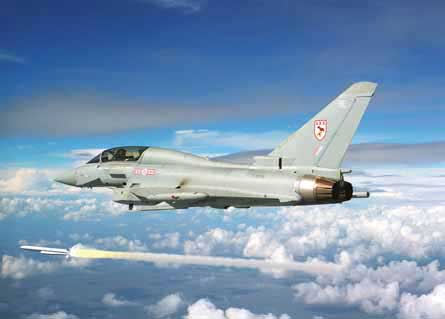Most of the UK's big procurement projects are continuing to plan but Typhoon overspend is still commercial secret
The UK Ministry of Defence is doing a better job of keeping its biggest defence procurement projects on time and budget, although the MBDA Meteor long-range air-to-air missile is now set to enter service a year late, in August 2013. The MoD is also still refusing to disclose what it expects to spend on acquiring Eurofighter Typhoons for reasons of "commercial sensitivity".
The latest annual report by the government's spending watchdog, the National Audit Office (NAO), looks at progress on the MoD's 20 largest current acquisitions (or 19, as the Lockheed Martin F-35 - or Future Joint Combat Aircraft as it is known in the UK - is excluded as its in-service date has not been agreed), worth a total of £27 billion ($51 billion).
|
|---|
The MBDA Meteor long-range air-to-air missile is now expected to enter service a year late, in August 2013 |
It finds that - despite lingering severe delays on several legacy programmes, including 89 months on the BAE Systems Nimrod MRA4 maritime reconnaissance aircraft - 11 of its projects stayed on schedule during the year to 31 March 2006. These included Nimrod, as well as the Airbus Military A400M and Typhoon.
However, four other programmes, including the Type 45 destroyer, saw their service entry dates slide. With two projects ahead of last year's schedule, the total slippage was 33 months, or an average of 1.7 months per acquisition. That is an improvement on the 2.4 months in the Major Projects Report for 2004-5.
Nevertheless, the NAO berates an "historically poor performance", with the 19 projects in question expected to be delivered a total of 36 years later than at approval.
It is not entirely clear who is chiefly to blame for the Meteor slippage, which the NAO says is a result of "Typhoon integration delays", particularly finding an aircraft on which to test the system. The Meteor was originally expected to enter service in September 2011, but the delay will not add to acquisition costs.
Eurofighter says it has "submitted a number of proposals to the customer on integration of Meteor onto Eurofighter Typhoon".
The decision for the second year to omit all new costs in the report associated with the Typhoon acquisition - other than the £16.7 billion budgeted at approval and £10.6 billion itemised to March 2006 - remains controversial and puzzling. The report goes into great detail about tiny variations on programmes costing a fraction of the Typhoon's budget, but a potential overspend of more than £2 billion is unidentified because the government fears it could compromise negotiations for the third tranche of aircraft. "The MoD has asked us not to reveal any details because of the commercial sensitivity," says the NAO.
The total cost forecast for the 20 projects is £27 billion, 11% up on the sums approved at "main gate". This year the NAO, rather than focusing on the trends and reasons for cost movements over the year, has looked more at the MoD's ability to "live within its means" by reallocating costs to other budgets and reassessing quantities required. It says the MoD has been successful in doing this, ramping back costs on the 20 projects by £781 million, equivalent to a 21% reduction in the overall cost increases since main gate.
The report also says that 17 of the 20 projects are expected to meet all of their "key user requirements", one fewer than last year's report. Thirteen key user requirements on seven projects are considered to be "at risk". These include a problem identified in October last year with the Typhoon's maximum required speed at 36,000ft (11,000m) because of an "acoustic vibration within the engine intake which is causing the intake to resonate at very high speeds", and could have "potential long-term fatigue implications". Another at-risk issue was also picked up on Nimrod in March this year with its anti-submarine warfare capability, which the report says has now been resolved by the addition of an electronic warfare rig.
The NAO says "technical factors" remain the "largest cause of the increased risks to the projects", and suggests that the MoD may have to "make trade-offs in capability to keep within its budget and in-service date parameters".
Assessing the impact of Meteor missing its target The one-year delay in the Meteor's in-service date could mean the missile will have to wait until the third tranche of Typhoons goes into service to be deployed. The report says the delay will mean increasing reliance on the less-capable Raytheon Missile Systems AIM-120 advanced medium-range air-to-air missile (AMRAAM) on the 144 UK Typhoons due to enter service in the first two tranches. The decision on the final tranche of 88 aircraft does not have to be made until at least next year. While not affecting "peacetime policing", the slippage will compromise the "survivability and capability of the Typhoon in almost all operational roles", says the report, which also warns of a "significant risk" that AMRAAM stocks may not be able to meet the new in-service date of the Meteor. |
|---|
Source: Flight International
























